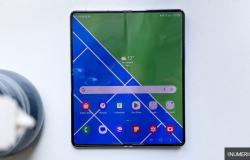If the machine was generally quite well received, one thing annoys: the integrated storage! With only 256GB of base, this mini-Mac requires customers to spend a fortune to upgrade to 512GB (+230€) or 1TB (460€!)! We largely double the price of the machine to have 2TB, while this capacity costs less than €130 commercially, for equivalent performance.

There remains the option of external SSDs, the Crucial X9 for example costs only €892TB at €132, which proves that Apple is making money on internal storage, sold at least 10 times too expensive.

For our part, we opted for a Samsung T9 (€144/1TB) which is close to 1GB/s on Mac mini M4sbut which could double these speeds if Macs supported USB 3.2 Gen 2×2:

To exceed these speeds, you have to use Thunderbolt 4, as with this Zike box which costs €138 on its own (without SSD!). In return, we achieve pretty crazy speeds, 4GB/s writing and more than 3GB/s reading with a Crucial P3 Plus SSD:

Restricted SSDs?
The argument to defend this pricing policy concerned the speed of Apple's SSDs, historically higher than market solutions. Gold on our 256GB model, the speeds are lower than those obtained with Thunderbolt 4 (4 GB/s writing and 3.5 GB/s reading), i.e. 2 GB/s writing and 2.8 GB/s reading :

It remains much better than the Mac mini M2 which only offered a single 256GB memory chip (compared to two here) and which did not exceed 1.5GB/s. On the other hand, a basic MacBook Pro M4 displays 3.5 GB/s in writing and 3 GB/s in reading, with still this same truly laughable capacity of 256 GB. Even more surprising, the Mac mini M4 is… slower than the Mac mini M1, released in 2020 (2.7GB/s and 3GB/s)). To obtain speeds that are really higher than Thunderbolt 4, you have to go to 512GB or even 1 or 2TB and you finally reach 4 to 7GB/s, as we will see in the test.
Removable memory chips
As some DIYers discovered when dismantling the machine, the dual memory chip of the SSD (the NAND on the daughter card) is not soldered to the motherboardwhich theoretically allows storage to be scaled.

In reality, these small cards are not standard and above all, these are not real SSDs, the controller being integrated into the M4 chip. The idea of being able to increase the internal storage is therefore theoretically possible, but very complicated in practice: some have fun resoldering memory chips directly on the card (which must already be unsoldered correctly, with expensive equipment). Others try to reproduce Apple's small proprietary cardbut subject to finding yourself blocked one day…

We can still console ourselves by knowing that in the event of a problem with the Mac, we can theoretically recover the datawhich is not the case in many Macs where the memory is soldered, especially in laptops. But in practice, it is not always simple, because Apple greatly complicates the life of tinkerers, by encrypting the data with the machine…

When will there be M.2 slots?
If Apple listened to its customers, it would have placed an NVME SSD in M.2 format, there is plenty of room in the caseand this would have made it possible to increase the storage for a pittance. This strategy from Tim Cook, who has been working on Macs for more than 10 years, is becoming frankly ridiculous, to the point that even YouTubers who are generally accommodating to Apple, like MKBHD, are starting to get annoyed about it publicly.
Realize, the Mac mini of 2010 already offered 320GB basic, and 1TB optional. Of course, these were platter disks, but we are still talking about useful capacities 14 years ago, while in the meantime, photos and videos have still grown considerably, not to mention the rest .
Which SSDs for the Mac mini M4?
Here are some SSDs that we use in the editorial office and with which we have not had any particular problems for several years:





